By Tristan Colaizzi
Since the creation of the Joker in DC Comic’s original Batman in 1940, he has been known as the green haired villain to the bat. From the original comics to the most recent round of batman movies and now Suicide Squad, the Joker has been played by many actors and characterized by numerous artists, taking on a variety of different forms to fit the changing times. Canonized by his purple coat and manacle laugh, the Joker is on par with Darth Vader and Hannibal Lecter as one of the most recognizable villains of all time. A quick internet search will show the breadth of following and obsession that he has created and the variety of forms he has taken on. In the most recent interpretation, even the villainry of the Joker is modified as he’s portrayed as a hero, not an evil villain. His desire throughout Suicide Squad is to save Harley Quinn, and when he comes so close, but fails to and dies, we feel devastated. In the end, however, the Joker returns and rescues Harley Quinn from her cell.
It should come as no surprise, then, that in a turbulent world pertaining to the rights and discrimination of sexual identity and queerness that the latest rendition of the Joker does not fit the heterosexual male mold he has in the past. In Suicide Squad, while still maintaining the classic image of the Joker, he, or rather she, becomes the villain you root for in a movie that has flipped good and evil, straight and queer. In order to deconstruct the movie’s gendered sub-plot, a revenge of the transgender, let’s focus on three key elements of his character: the actor who plays the Joker, the physical appearance of the Joker, and the actions of the Joker.
The Actor
Suicide Squad’s Joker is not a cartoon from a DC comic. Instead, He is a Jared Leto, a carefully picked actor. It is important to note the associations that Leto carries with him. Although being known for looking like a twenty-first century Jesus, Leto is a rumored bisexual, and although that is a very different identity from that of being trans, it still falls under the category of queer, or rather not heteronormative. More importantly, Jared is known for his Golden Globe and Academy award performance as Rayon, a transgender dying of AIDS, in Dallas buyers’ club. Rayon is always in drag, focused more on her beauty and femininity than her life threatening disease. She is the trans that millennials know best and conforms to every trans stereotype imaginable. Jared’s association with Rayon cannot be overemphasized, as it is an identity that will now color ever performance he does. The casting directors of Suicide Squad are undoubtedly aware that they not only are casting Jared, but are also in a way casting Rayon. Furthermore, Jared’s facial structure, although a male face, caries feminine traits. His narrower nose and thinner, sharper lower facial structure is far from the idealized masculine face as reported in The Morphometrics of “masculinity” in Human Faces which found that, “male faces with a higher masculinity attribution tended to have wider faces with a wider inter-orbital distance, a wider nose, thinner lips, and a larger, more rounded lower facial outline.” (Mitteroecker) This distinction is clear when comparing Jared’s more feminine face to that of Matt Damon’s masculine facial features below. It cannot be ignored that the new Joker is played by a man that is most associated with not being a man. In many respects Rayon is the prelude, of sorts, to Suicide Squad’s Joker. From her facial structure to hair to dress to makeup and everything in between.
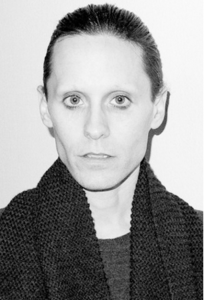

The appearance
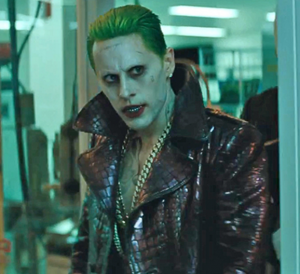
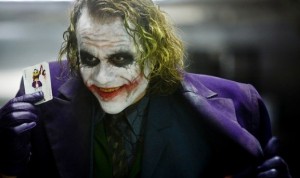
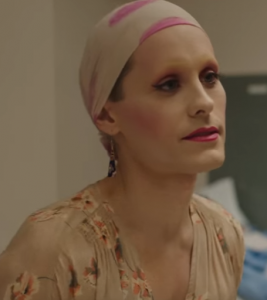
The Joker’s appearance can be read as a distancing from the old Joker, and into a new Joker dressed in Drag. It must be noted that, “Modern transgender performance is most widely known through drag” and therefore when examining a cultural piece such as Suicide Squad any crossdressing or drag performance can be equated to being transgender. (Miller 42)
Notice his makeup, his clothing, and his hair as they are unlike any Joker’s that we have seen before. His lipstick is noticed first, in 2008 the Joker had red lipstick sloppily drawn across his face that covered literal scars he had cut into his cheeks, making him look especially villainous and evil, like he was wearing a mask. In contrast, the new Joker’s red lipstick appears to be carefully applied, like a woman at a ball. The new Joker’s eyeshadow is quite light and tasteful, sexualizing the eyes instead of demonizing them as the old Joker’s eyeshadow does. Finally, there is the matter of paleness that all Jokers have on account for being a clown. The 2008 Joker has cracks in his white foundation and other makeup clearly smudging around his face. It appears as though he did a poor job applying clown makeup. In sharp contrast, the new 2016 Joker’s foundation can almost be missed on account for how well it was put on. The appeared effort and cleanliness, as well as feminine manner that new Joker’s makeup is applied is easily relatable to the makeup of Rayon in her drag. By making the two characters look so similar, the director is intentionally forcing you to picture the new Joker with any non-male person in mind, particularly Rayon.
Paying close attention to the new Joker’s hair reveals that it is much more similar to the style of Rayon than that of the 2008 Joker. In 2008, his hair is longer and is a faded disheveled green, falling in front of his face, whereas Suicide Squad’s Joker has well-kept slicked back hair. There are a few places that we can see this style of hair. One is in the early twentieth century where men often slicked back their hair as it was the popular style of the day, however, more likely (as this movie holds no other similarities to that time period) is that the Joker’s hair is slicked back because it is ready to be put up in a do rag, like the one we see on Rayon, or it is being prepared for a wig, as any short hair would have needed to be controlled and minimized to make the appearance of the wig natural.
In the final layer, the Joker’s famous purple jacket, we can see an important distinction between the two interpretations. In 2008, it was put over a green vest, dress shirt and tie. The three-piece outfit was dirty and too big, but nonetheless masculine, turning the joker into more of a twisted businessman than anything else. But, in 2016 we see no shirt, not tie and no vest. His jacket, now made out of alligator skin, a material largely associated with high feminine fashion, is shiny and unbuttoned with a popped collar and is much longer, going all the way to his shins, resembling something closer to a ballroom gown with too much cleavage than a three-piece businessman’s suit. Particularly noting that the Joker’s jacket almost always covers his nipples, but nonetheless shows a striking amount of cleavage, allows us to draw close analogy to the dress of Rayon as pictured below. This all is to say that the Joker is dressed in drag, complete with a gown and makeup only different from Rayon in the lack of brunette wig, which the Joker could never have and still fit the comic book picture that has existed for over 60 years.
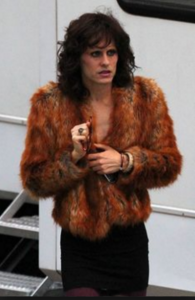
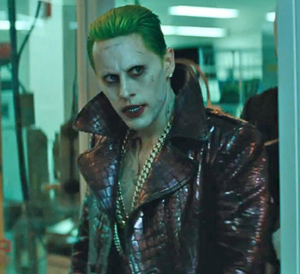
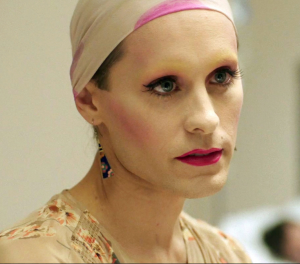
The Actions
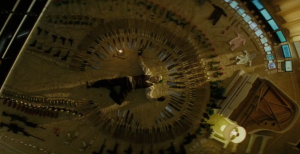
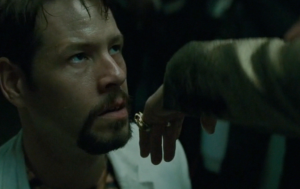
The masterstroke, and final peace to the puzzle that turns the Joker from male to transgender are actions. The clarifying scene is in what appears to be a penthouse living room. The scene is pictured above and shows the Joker lying in the middle of a circle with a hammer and lightbulb, surrounded by knives, roses and baby clothes.
The lightbulb and hammer go hand in hand to symbolize an idea or rather a desire for enlightenment facilitated by a tool that is the hammer. It is not the physical hammer that will achieve the enlightenment, but rather the idea that technology and tools are needed to achieve enlightenment. The brilliance of this shot comes from the layers of items that surround the Joker. At the center, are the knives, which traditionally symbolize destruction, and in a movie where the Joker never uses knives as a weapon, their placement in this shot must be purely symbolic. The knives exist to destroy, or rather surgically cut away, the part of the Joker that restrains him from becoming transgender. In destroying that part of him, his penis, he can reach the next level of the circle, that of the roses. Roses are symbolic of love and in this case self-love of a physically transitioned Joker, because he has moved through the layer of knives to get to the roses. The roses complete the circle that really isn’t a circle, but rather a womb. The womb having only one opening that leads out of the penthouse. The Joker’s exiting of the penthouse is therefore an exiting of the womb, a rebirth into a new physical state as well as mental state. Then there is the matter of what is outside of the womb, three baby outfits. The inclusion of these outfits only further solidifies the concept of rebirth into a new body. The joker has destroyed the part of him that he dislikes and in doing so is enlightened as he has found self-love in rebirth.
In the next scene, immediately after exiting of penthouse, the Joker takes on much more sexual, feminine, and queer characteristics. She enters the next scene purring at the man who is being interrogated. The Joker then presents her hand to be kissed. It is important to notice how she presents her hand, not as a fist, but rather like a queen or woman would present her hand to a man. By making the straight man kiss her hand the Joker, now fully transgendered, is asserting dominance over the heterosexual norm. This concept is completed when the Joker sits on the man’s lap, crotch to crotch and sexually growls again. Her dominance in this scene, although subtle, sets up a new power dynamic in the movie. It does so because the man who was being interrogated once held all the power over Harley Quinn and therefore, by the Jokers obsession of freeing her, the power over the Joker. The establishment of this power dynamic is completed in the final scene of the movie, where the Joker breaks into the jail that houses Harley Quinn and frees her, giving the Transgender the final move and final laugh.
Taken together these three elements create a new Joker that we have never seen before. We have a transgender villain that instead of being a villain is the hero that we root for, and in the end is the person with the most power. We see a movie that has redefined gender dynamics in a comic book world where men have historically ruled.
As a movie it is entertaining.
As a story it is revolutionary.
Written in the style of Jake Romm
Edited by Abby Lloyd
Sources
Miller, Jeremy Russel. “Crossdressing Cinema: An Analysis of Transgender Representation in Film.” PhD diss., Texas A&M University, 2012. Accessed December 13, 2016. http://oaktrust.library.tamu.edu/bitstream/handle/1969.1/ETD-TAMU-2012-08-11672/ MILLER-DISSERTATION.pdf.
Mitteroecker, Philipp. “The Morphometrics of “Masculinity” in Human Faces.” PLOS one, February 11, 2015. http://journals.plos.org/plosone/article?id=10.1371/journal.pone.0118374.
Ledger, Heath. Dark Night. Directed by Christopher Nolan. DC entertainment, 2008.
Leto, Jared. Suicide Squad. Directed by David Ayer. DC entertainment, 2016.
Leto, Jared. Dallas Buyers Club. Directed by Jean-Marc Vallee. Voltage Pictures, 2013.